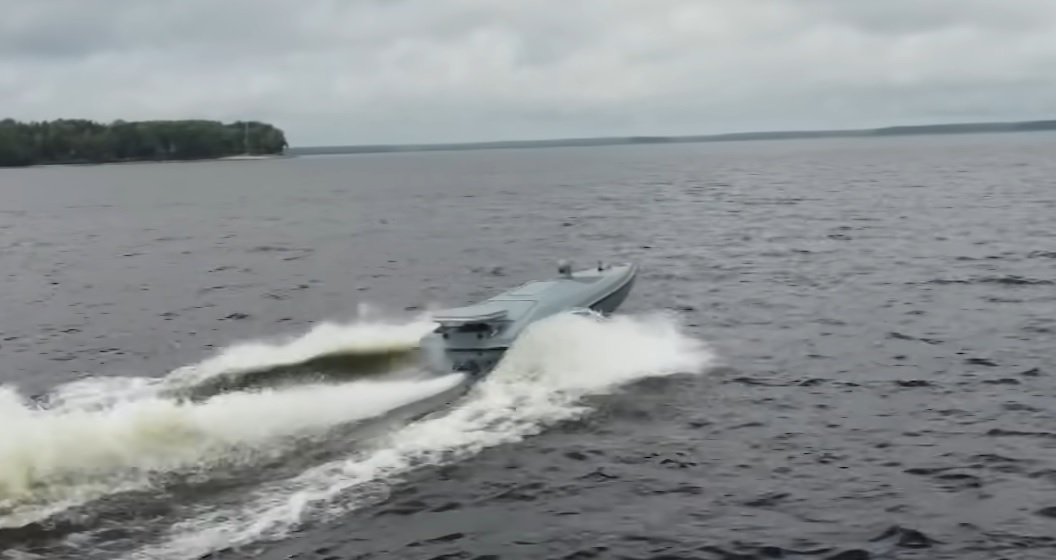Podcast blog Ukrainian Jenny meets... has published an interview with a person from one of the most secretive units of the Ukrainian Armed Forces which, paradoxically, is known all too well — the Group 13, a team of operators for the Magura V5 unmanned surface vessels. These maneuverable remote-controlled boats filled with explosives have become a terror for the russian Black Sea Fleet, with eight targets sunk and six more attacked by Magura.
Commander 13th is the head of this special team, belonging to the Defense Intelligence of Ukraine, and so far the only known member to speak publicly in the few interviews he's given to the media. Defense Express provides a few key takeaways from his hour-long talk with journalist Jenny Klochko, while the original is available on her YouTube channel.
Read more: Plastic Magura V5 Sea Drones are Invisible to Radars, Says Chief Operator
First, The 13th reveals some previously unknown or vague specifications of the relevant version of Magura V5. Contrary to his previous interview, the length of the boat is once again down to 5.5 meters, according to the information Jenny operates with.

The 13th himself added that the drone's range of 800 km widely known to the press is the "guaranteed" operating range but his people used to steer Magura at even larger distances. Even so, 800 km is enough for 80 to 90% of missions in the Black Sea.
Also, the amount of explosive filling varies depending on the task and target: the standard is 250 kilograms but it can be expanded to 320 kg without any loss of mobility or removing equipment.
This was mentioned in the context of comparing Magura with other boat drones like SeaBaby, Kozak Mamai, or Mykola which offer increased explosive payloads. The 13th says he doesn't know much of those who operate these drones but believes that the increase in firepower is irrelevant to the tasks his particular unit needs to accomplish.
For a reminder, the Magura V5 drones are known for devastating attacks on russian warships cruising in the Black Sea, most prominent achievements include the sinking of the Sergey Kotov patrol ship and the Caesar Kunikov landing craft. In regards to the first one, Commander 13th says it was the toughest target to take down, it was attacked three times, and even the last time, which became fatal to this ship, his people were not sure if they managed to sink it until intelligence reports published the following morning.

Moreover, what made that mission so challenging was partly due to the russian crew of Sergey Kotov who put up a fight before being sunk:
"Sergey Kotov's team was working well together, I can't say they were useless. Each of them knew what to do. Their work was well-coordinated, and it affected our work. It all depends. We have to understand the importance of human factors because there's a person behind each weapon," The 13th said while explaining what makes a tough target for Magura.

The highlight of the interview is the tactic his unit has developed against russian warships over countless sorties:
"We have a special technique that we use. The first drone must reach the target because after that, we have an algorithm. It is essential for the first drone to hit and it does not matter where exactly. It must attack the ship, no matter what part is going to be damaged. Why? Because we have an explosion, followed by the disruption of the work for the ship crew. The ship loses its strength, and then we finish it off with precise and calculated attacks."
He calls the first drone to approach the vessel a "hooligan," whose main aim is to start to fight. There's also an interesting bit about the adaptability his team sometimes needs to overcome unexpected problems during missions, like that time one of Magura drones' explosion trigger sensors turned off due to malfunction, in the highlighted clip:
The interview brings one extra detail about the cost of this drone which remains subject to debate. Upon hearing the price tag of $230,000 per Magura V5, sourced from public data, he said it was lower, especially for Ukraine. What it likely means, Defense Express notes, is that $230,000 is the export price of the system, developed by an unknown Ukrainian company.
The russians earlier managed to capture one of the Magura drones and — based on the electronics and other parts found inside — estimated its cost at around $250,000. The 13th recalls this instance as unfortunate but says it wasn't too critical because Magura V5 has evolved since then: "They look similar but technologies and software are updated and modernized," he noted.
Lastly, speaking of the prospects of naval warfare in general, The 13th agreed that sea drones revolutionize the way we see war in this domain but ultimately, drones like Magura V5 should be a good addition to conventional fleet which Ukraine currently does not possess.

Read more: Innovative Combat: Ukrainian Troops Use FPV Drones with Mounted Weapons (Video)














